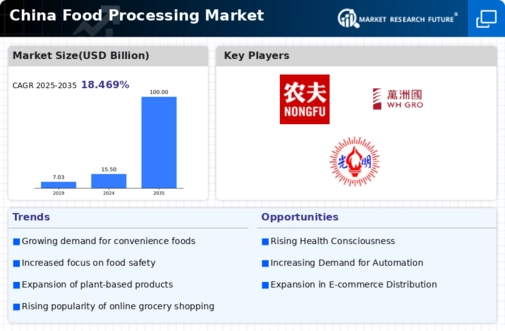Rising Urbanization
The rapid urbanization in China is a pivotal driver for the food processing market. As more individuals migrate to urban areas, the demand for processed food products increases significantly. Urban consumers often seek convenience, leading to a surge in ready-to-eat meals and packaged foods. According to recent data, urban areas in China are projected to account for over 60% of the total food consumption by 2025. This shift not only influences consumer preferences but also compels food processing companies to innovate and adapt their offerings to meet the evolving needs of urban dwellers. The food processing market needs to respond to this trend by enhancing distribution channels and ensuring product availability in urban centers.
Growing Health Awareness
The increasing health awareness among Chinese consumers is a notable driver for the food processing market. As individuals become more conscious of their dietary choices, there is a rising demand for healthier processed food options. This trend is reflected in the growing popularity of products that are low in sugar, fat, and artificial additives. Market data suggests that health-oriented processed foods are expected to grow by approximately 20% over the next few years. Food processing companies are responding by reformulating existing products and introducing new lines that align with health trends. This shift not only caters to consumer preferences but also positions companies favorably in a competitive market.
Technological Advancements
Technological advancements play a significant role in shaping the food processing market in China. Innovations in processing techniques, such as high-pressure processing and advanced preservation methods, enhance product quality and shelf life. Furthermore, automation and smart technologies are increasingly being integrated into production lines, improving efficiency and reducing operational costs. The food processing market is likely to see a growth rate of around 10% annually as companies adopt these technologies. This trend not only boosts productivity but also allows for the development of new products that meet consumer demands for quality and safety. As a result, companies that invest in technology are better positioned to compete in the evolving market landscape.
Evolving Consumer Preferences
Consumer preferences in China are shifting towards more diverse and convenient food options, which is a crucial driver for the food processing market. With an increasing focus on flavor variety and convenience, consumers are gravitating towards processed foods that offer quick meal solutions. Data indicates that the demand for frozen and pre-packaged foods has risen by approximately 15% in recent years. This trend suggests that food processing companies need to diversify their product lines to cater to these changing tastes. Additionally, the rise of e-commerce platforms has further facilitated access to a wide range of processed food products, thereby expanding the market reach for food processing companies.
Regulatory Support and Standards
Regulatory support and the establishment of food safety standards are critical drivers for the food processing market in China. The government has implemented stringent regulations to ensure food safety and quality, which has led to increased consumer trust in processed food products. Compliance with these regulations often requires food processing companies to invest in better quality control measures and certifications. As a result, the market is witnessing a shift towards higher quality standards, which could potentially increase production costs but also enhance product value. The food processing market is expected to benefit from these regulations as they promote safer and more reliable food products, ultimately driving consumer demand.














Leave a Comment